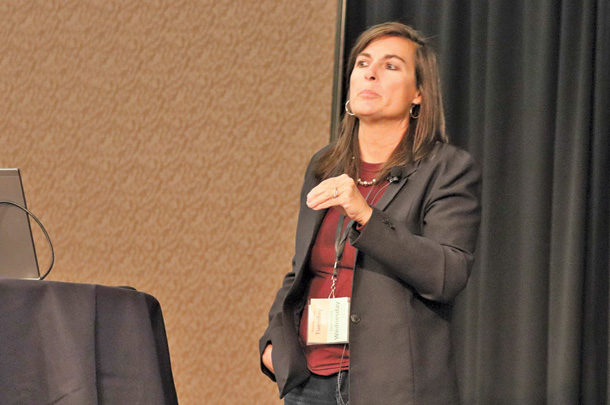Seeking a new pattern of thinking for the new year? Not only can developing that habit spark new creativity, it could also pay off in your bottom line.
Karla Wilke, associate professor for the University of Nebraska’s Panhandle Research and Extension Center, told producers at the 2021 Range Beef Cow Symposium “to challenge your thinking on some paradigms we have” for cow-calf and a stocker operations.
Cow-calf producers adding yearlings
Drought isn’t just a once-in-a-decade issue anymore but rather more persistent and frequent. So, operations that utilize cow-calf pairs may want to consider a strategy to add more yearlings and diversify their income – and to reduce stress on grazing lands in a drought. Wilke said the average cow-calf pair, usually at 1,700 pounds (1,300-pound cow, 400-pound calf), comes in at roughly 1.7 animal units monthly (AUM). But yearlings average 850 pounds, or approximately 0.85 AUMs. So, two yearlings could be removed from drought-stressed pasture in place of a cow-calf pair. “So basically, if you were at a position that you needed to remove some animals from pasture for sustainability reasons because it was too much of a drought, you could remove two yearlings or one of those cow-calf pairs. And you’re going to sell the yearlings anyway, and you might be selling them early.”
The entire formula is made more crucial considering how high-genetic cows may have to be sold in a severe drought, forcing a low-value option during liquidation due to cow depreciation. Wilke defined cow depreciation as the purchase or development price, if you’re developing heifers, that it took you to get that cow, minus the salvage value you sold her for, divided by the number of productive years she had a calf. For example, if a cow is purchased for $2,000 and sold for $800 after three successful calving years, that equals a $400 depreciation cost for the cow. “My point being, selling productive cows due to forced liquidation is costly to your operation. And so, we want to try to mitigate that plan.”
Income diversification, with different weight classes and marketing points for yearlings, can also provide benefits. But that requires a close look at location, forage resources, labor and managing risk. Other questions Wilke noted for adopting yearlings:
- What equipment is available for feed?
- What genetics are in the herd?
- What would a stocker operation be for what you develop?
- What strategies exist for winter/summer grazing and feedlot entry?
Winter supplementation
Wilke said the other assumption to challenge is how producers properly adopt winter supplement strategies through winter grazing periods. Most producers use supplements on winter calves after weaning, but more with survival than investment in mind. “Many producers target under or equal to 1 pound a day gain to ride out the winter hoping to take advantage of compensatory gain when they go to summer grass, then pick up some really good gain,” she said. “But we have several studies that would indicate that calves supplemented at a higher rate of gain in the winter will still be heavier at the end of summer grazing and more cost effective.”
Wilke’s own study in 2009 showed that calves not supplemented on range but compensated on wheat pasture resulted in the same bodyweight as calves supplemented at 0.25% of their bodyweight level. However, those selling after wheat pasture grazing and those that received 0.5% of their bodyweight in winter supplement showed more improvement than the non-supplemented and the 0.25% group. “So the conclusion from that study was the calves not supplemented on range, compensated on wheat pasture, got the same bodyweight as the lowest level of supplementation.”
Other studies showed final bodyweight was higher after finishing when calves were supplemented for a higher rate of winter gain. Another meta-analysis study from 2015 (see Table 1) reflected similar results. Although that study only targeted a low-gain point of 0.5 pound per day, and 1.5 pounds per day, “the final bodyweight was still heaviest for the highest treatment without differences in total dry matter intake or feed efficiency,” Wilke said.

A third study cited by Wilke focused on 18 years of monthly auction data charting those who used 0.8 pound a day, or a higher 2 pounds a day, winter-gain target, with a marketing target for July or September. Those utilizing the higher amounts of winter supplementation and gain, with marketing in September, had more favorable profits. ![]()
PHOTO: Karla Wilke of the University of Nebraska – Lincoln. Photo by David Cooper.







